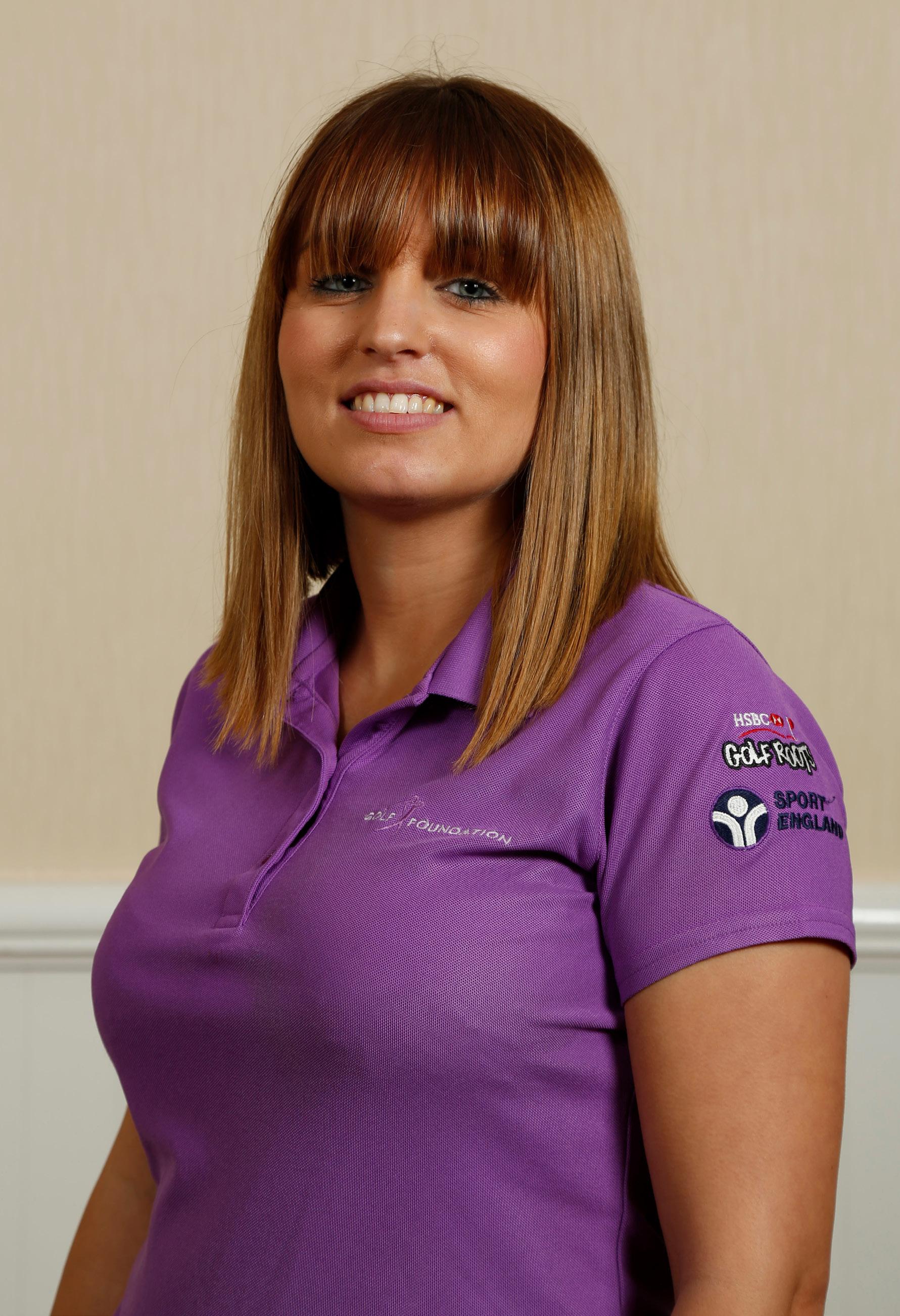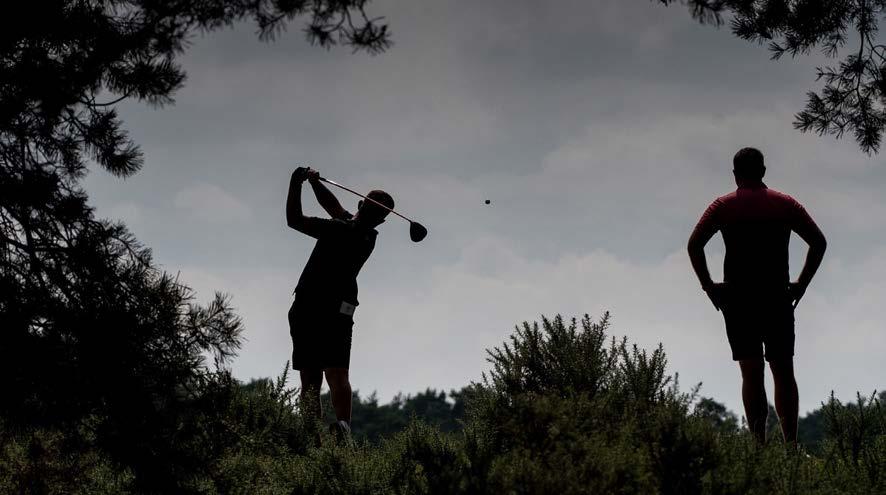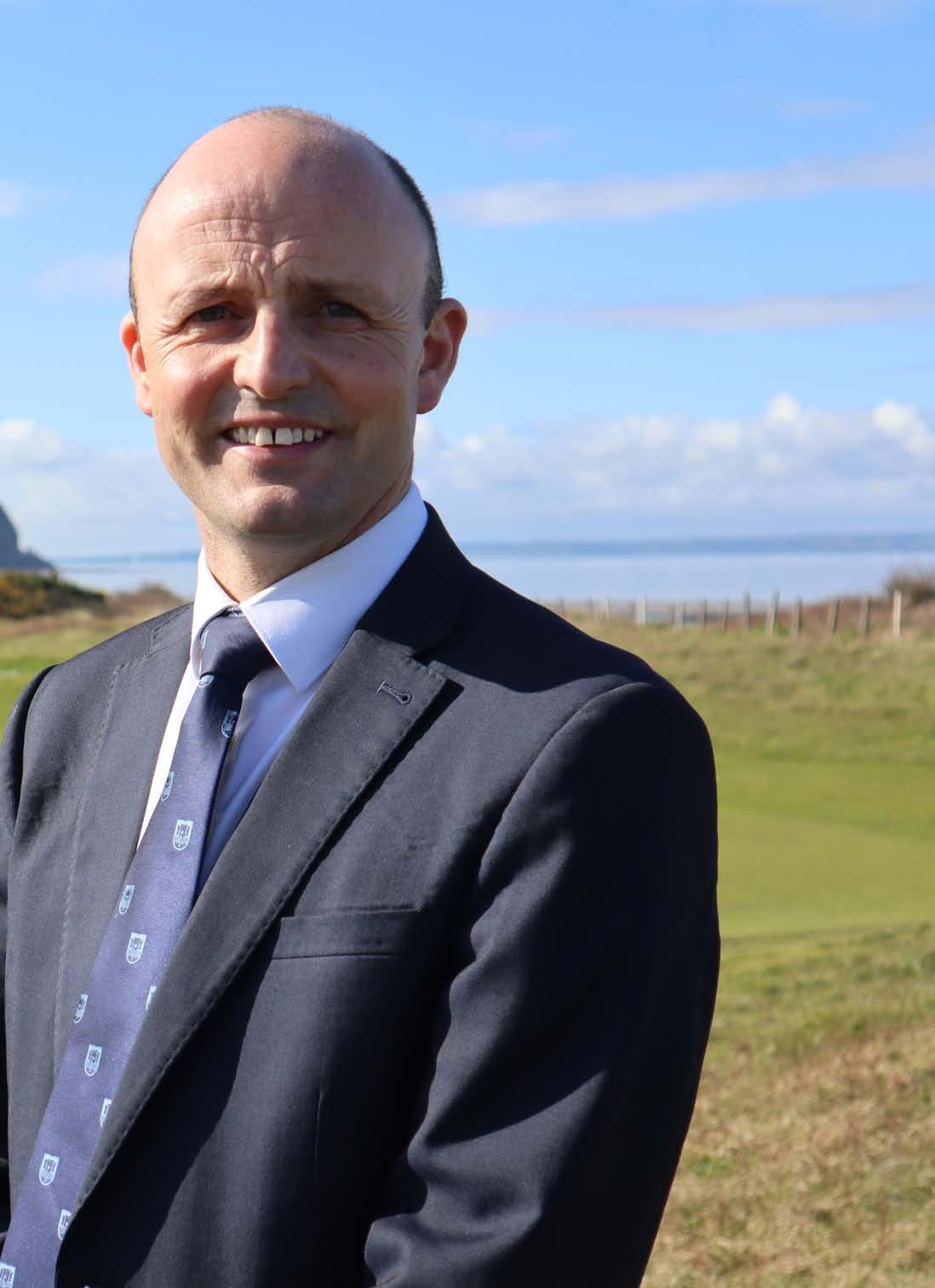
23 minute read
Conwy’s Matt Parsley
Covid-19 has obviously dominated 2020. How did it first affect the club?
Like most people it was a shock to begin with. Once it became apparent that things were going to change for the foreseeable future, it was very difficult to try and imagine how the golf club would operate with so many fundamental changes
Advertisement
In early March, we were all set up, ready to go with our budgets agreed for the year, our staff in place and motivated and our targets in place. We have invested heavily on the course and the clubhouse infrastructure over the last two years, so this year
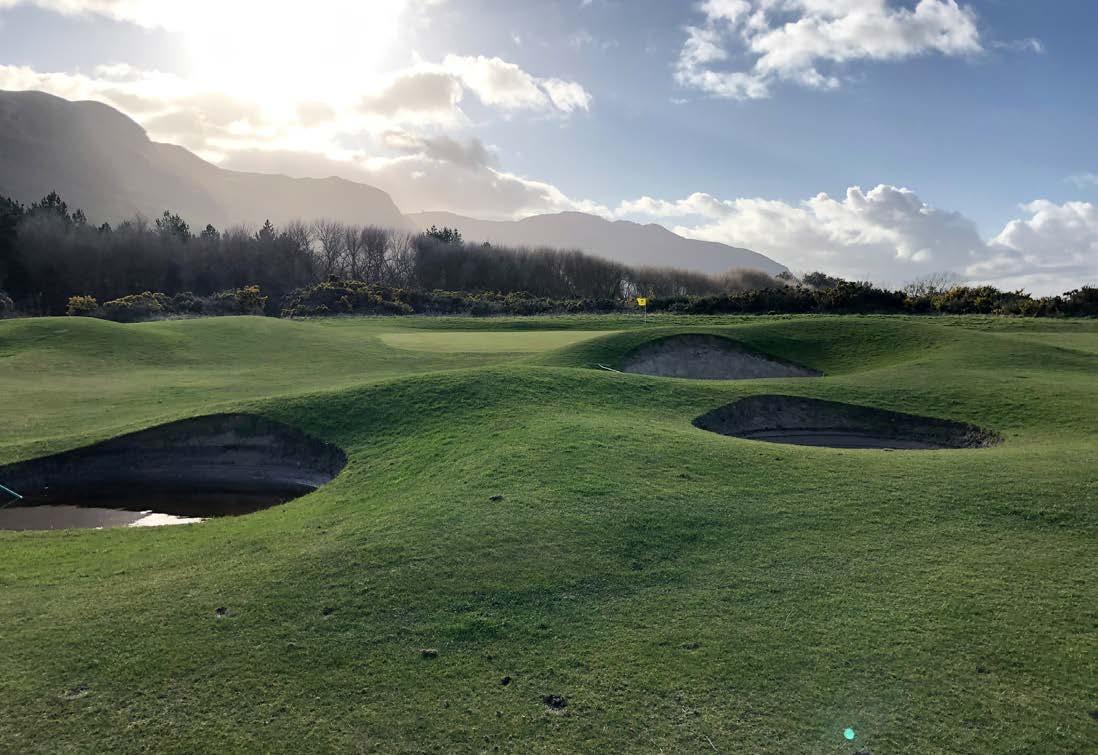
was going to be pivotal in our development. Our pre-bookings were good and we were on track to have our best year ever.
Then Covid-19 came and we had to review everything. It was a stressful and challenging situation for me as the club manager. I have had to draw on all my experiences. It is my belief that, for any manager, it is important in times of crisis not to panic and show strong leadership to those around. This certainly was a crisis on a Global scale!
So that is what I did. I worked hard and made a plan to try and secure the future for staff, members and visitors.
Making sure everyone was safe and understood the situation was the priority. I’m fortunate to have good staff and committee members around me. So one of the first things I did was to set up a Covid Management Group. This was made up of the senior staff that I meet with on a weekly basis. The big difference was we were meeting daily, or hourly sometimes, not just weekly,
Information was changing all the time so it was a very reactive situation, which is not how we normally work.
We reduced the staffing numbers to five people. We are a 28 staff organisation but once we understood the furlough scheme, and what it was going to look like, we ended up with five key staff to manage the club operations
through lockdown. We worked right the way through lockdown. It was tough to see staff go onto furlough and we had to make some redundancies too; for me that was the hardest thing to do, but it was the right thing to do for the club. The five remaining people, the ‘COVID TEAM’, worked hard to keep the course and administration functioning. Our club pro moved onto the course, which worked very well, and I felt the whole team came together, accepted the situation and worked hard to deal with the challenges on a daily basis, which was great to see.
I also set up a team of committee members to work through the budgets with me and look at the effects to the membership and visitor bookings. That was the chairman of our Management Committee, the finance chair and myself. I dread to think how many draft budgets we set and then changed but, by early May, we had what we felt was a realistic ‘Covid budget’ that we presented to the Management Committee.
We have worked to that since then. We got some things right and some wrong but we weren’t a million miles away.
It was a tough and stressful three months, but we got through it and we managed to open the course to members in May and to visitors in July. It was so good to see people back at the club, it really made all the hard work worthwhile.
The golf course benefited from having a rest. I like to try to take the positives out of everything and we managed to get some growth in areas where we had been struggling for years.
As with many North Wales businesses, we rely on revenue from visitors travelling from outside the local area. So to lose April, May, June and most of July for visitor revenue meant around 60% of our total income was lost.
It was really hard to even imagine trying to deal with that. The challenge then was to plug the hole, reduce the loss, and cut some costs that weren’t detrimental to the club. I am fortunate that I enjoy my job, but Covid has certainly taken a lot of the fun out of it. All we have now is the tough parts of the job…all of the time!
How easy was it to stay patient in Wales when things started to reopen across the UK? You’re dealing with restrictions but a few miles away in England it’s completely different… Yes, very difficult and confusing. Due to our location we have large numbers of members and visitors who live in England. So it was one set of rules for people who live a 45 minute drive away in England and another set for us, but that’s Devolution for you, which is normal for us in Wales. We’ve felt like we were six weeks behind all the time. All the restrictions lifted earlier over the border but Wales took a more cautious approach.
Communication became the key. Sending out member updates and communicating what the rules were in Wales was a big part of the job and, thankfully, the members have been very understanding.
Then you were under increased lockdown before the Welsh Government introduced a nationwide ‘circuit breaker’… Yes, as we speak we are planning to into a 17-day National Lockdown from October 23. This means the golf course and clubhouse will be closed. The county lockdown started on October 1 and no travel was allowed outside of our county; so, we and all other local businesses
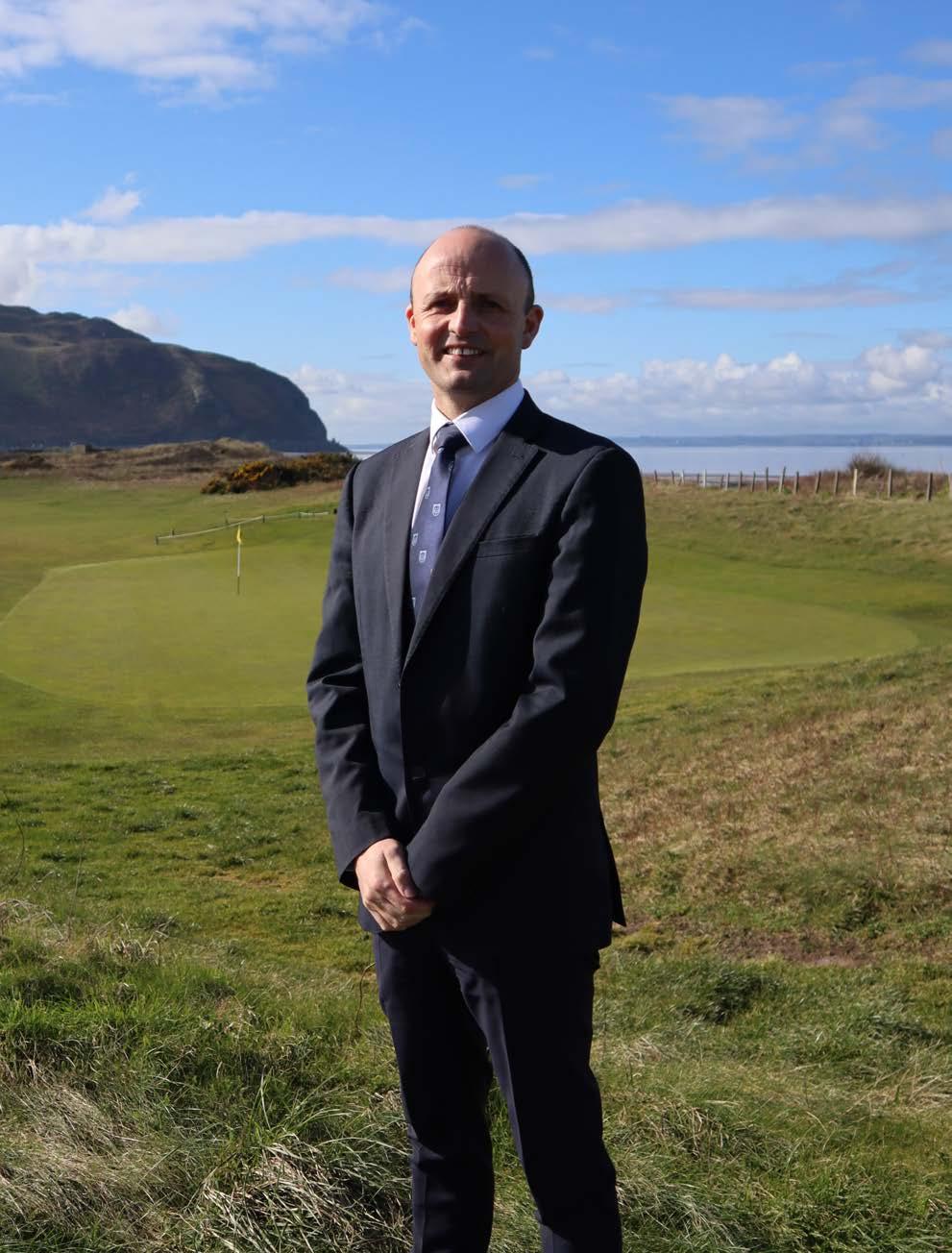

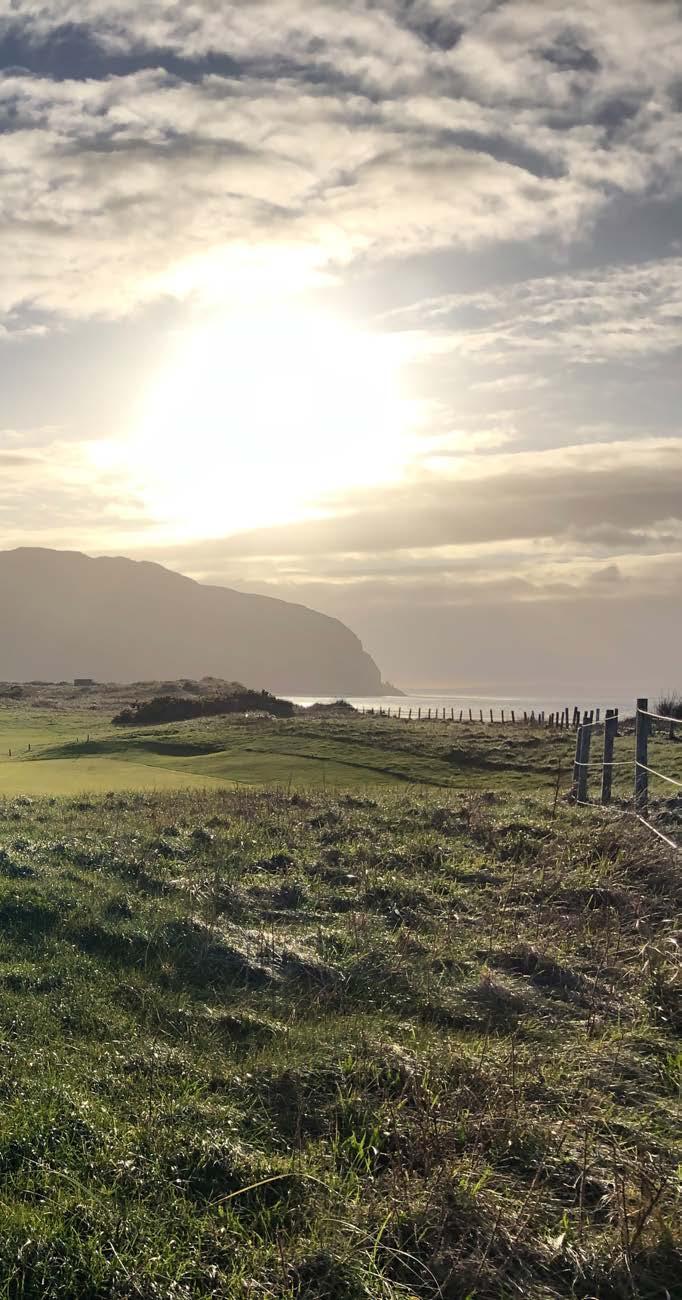
basically lost the last five weeks of the Autumn season, which is hard to believe. Again this is only Wales, the other UK government’s have all taken different decisions.
Our tee sheet for October was full of members and visitors. We didn’t have a visitor time left. So we had to contact all of our bookings, ask where they were travelling from. If they were coming from outside the Conwy County, which 99% of the visitor bookings were, we had to inform them they couldn’t come. From a business and tourism point of view, that decision has been tough to take – when we felt golfers coming from out of the county and playing golf outdoors was a really low risk.
Now we have a much stricter national lockdown, like it was back in March, and I have found myself re-visiting what we did then – resurrecting our Covid management teams of staff and committee members. All I’ve been thinking about is ‘how we are going to do this and what effect is it going to have on the club?’
What will it be like after those two weeks? Will we get back to how we were in September, when it was almost business as usual? Or will it be a slow climb back?
It seems an impossible task to balance the needs of the economy and peoples wellbeing with the needs of the NHS. I don’t envy the task the Government faces, but I fear there is a long winter ahead.
It’s hard to plan when you don’t know what’s happening… It’s very reactive, which is not good for any business. It’s hard for us to plan anything because we don’t know what’s coming. Within 24 hours of that information coming out for the local lockdown, we had pre-booked £35k of green fee income taken from us in a matter
of hours. It just decimated our October tee sheet. That sort of thing is difficult to deal with and leaves you feeling sick and worrying about the future of the golf club.
It affects people’s livelihoods but so does the virus and we have to give respect to that. People have lost their lives. It’s a constant battle between the economy and people’s health. We’re trying to keep the business going, trying to keep employing staff, but it’s very difficult when we rely so heavily on visitors.
Our figures for August and September beat those of the same months in previous years but the increase doesn’t come close to making up the losses we incurred from April to July. If we could have got through October, for us as a business we would have clawed back and reduced the loss even more. To have that just taken away from us, overnight, is very difficult to deal with.
With the national lockdown, as I’ve said, people’s lives are the priority and the Government have got a very tough decision to make to try and balance the economy and lifestyles against livelihoods and wellbeing. I do believe, though, that golf poses a very low risk and does help with people’s health and wellbeing.
I can understand they are in a no-win situation. There is no answer that’s the right answer for everyone. We’ve got to accept it and my message to the staff and committee has been to react like we have done previously, do the best we can during the restrictions, communicate to the staff and members, and do what needs to be done. For any business, ultimately, it is about the bottom line and finances. As a general manager that is trying to run the business, and trying to keep it going, we need to understand what our bottom line is going to be after all this and what we can and can’t do. As a golfer, I try to relate so many things to a round of golf – it helps me see things clearly. So If this was a round of golf, we have had the worst front nine possible, nothing has been how we planned it, but we have picked ourselves up at the turn, birdied 10 and 11 then have just taken double bogey up 12. We are now stood on the 13th tee and not sure what’s coming next! Conwy was meant to host the Curtis Cup in June. Inevitably, it was postponed and has been rescheduled for 2021. Does it give everyone something to look forward to next year? It does. The R&A handled the situation very well. They are an excellent organisation to work with. They didn’t react too quickly. They took their time in making the decision and communicated it well with the club. They made the decision to postpone and

arranged another date for the match in 2021. It is something we are looking forward to. It has been a good experience to get part of the way there (this year). We got to the middle of March and were a couple of months away from hosting the event. We’d gone quite far down the line in terms of the organisation, so we know what’s coming. We are ready to start the planning again. When it was taken away from us, we realised how much we were looking forward
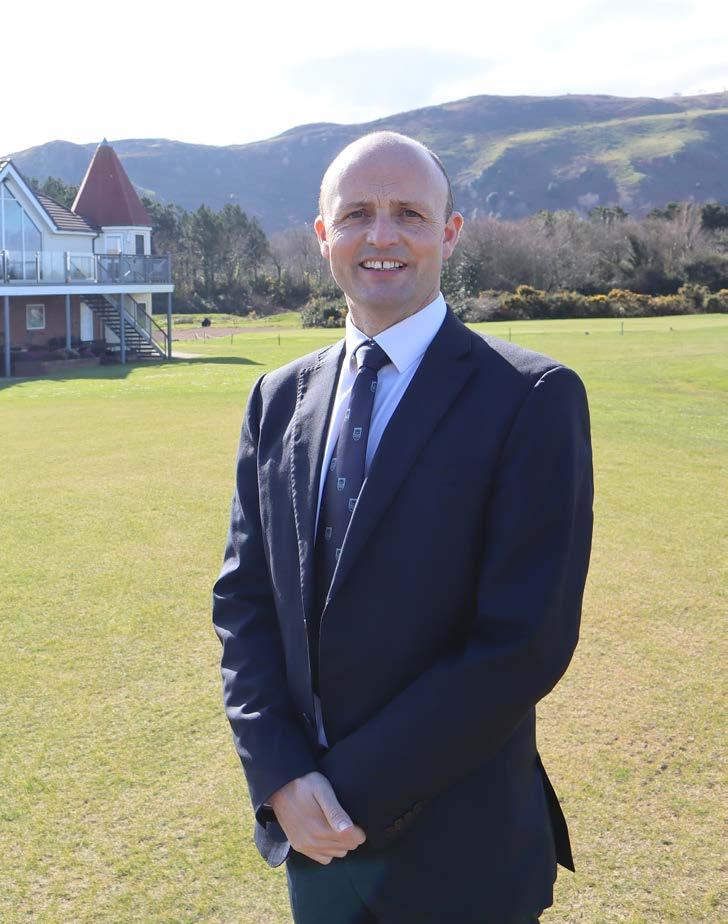
to it. I suppose we are looking forward to it even more now.
Whenever you are working with good people, and when you have a crisis situation, you do see what people are really about and they (R&A) handed it very well and were always keeping in contact with us. It’s only strengthened the relationship between the club and The R&A. It was a tough situation to go through but it was a good experience and I will take as many positives from it as I can. The tournament has transformed in size… The event itself has grown. 2012 at Nairn was a home win, which is always good. Some of those who’ve played have gone on to bigger and better things, including our own Amy Boulden. She was on the winning team at Nairn and has just recorded her first win on the LET!. So the profile of the event has raised. We’ve also got the first Curtis Cup that is R&A run – it has always been an LGU event – and, naturally, when
Matt Parsley Matt Parsley began playing golf aged 11 at the local municipal courses on the Wirral before joining Caldy Golf Club as a junior member with his brother and sister. His career in golf began as a trainee PGA professional at Royal Liverpool. He became a PGA club professional in 2000, completed the PGA director of golf qualification and served as club pro and secretary/manager at Holywell from 2008 until 2017. He joined Conwy as General Manager at the start of January 2018 – becoming the first to take the post at the Welsh club.
Conwy Conwy (Caernarvonshire) Golf Club is the third oldest club in Wales but is thought to be the first place where golf was played on Welsh soil. It’s found on the North Wales coast near the resort town of Conwy, famous for its castle, and lies at the mouth of the river. Formed in 1890, this championship links is highly rated for its variety and the beauty of its surroundings. It will host the Curtis Cup, the biennial battle between the best women amateurs from the United States and GB&I, next year after it was rescheduled because of the Covid-19 pandemic.
the R&A are involved the profile of any tournament is raised. We are committed to promoting Women and Girls’ Golf and we were the first club in the County to sign up to The R&A’s Women & Girls’ Charter.
It is a very special event and has huge tradition and importance for women’s golf. The event has a great following and there is very much a Curtis Cup family. My sister went to three Curtis Cups during the 90s to spectate, travelling to America for one of them! There’s a huge respect for the event and that’s what you start to realise. There’s definitely a special X-factor.
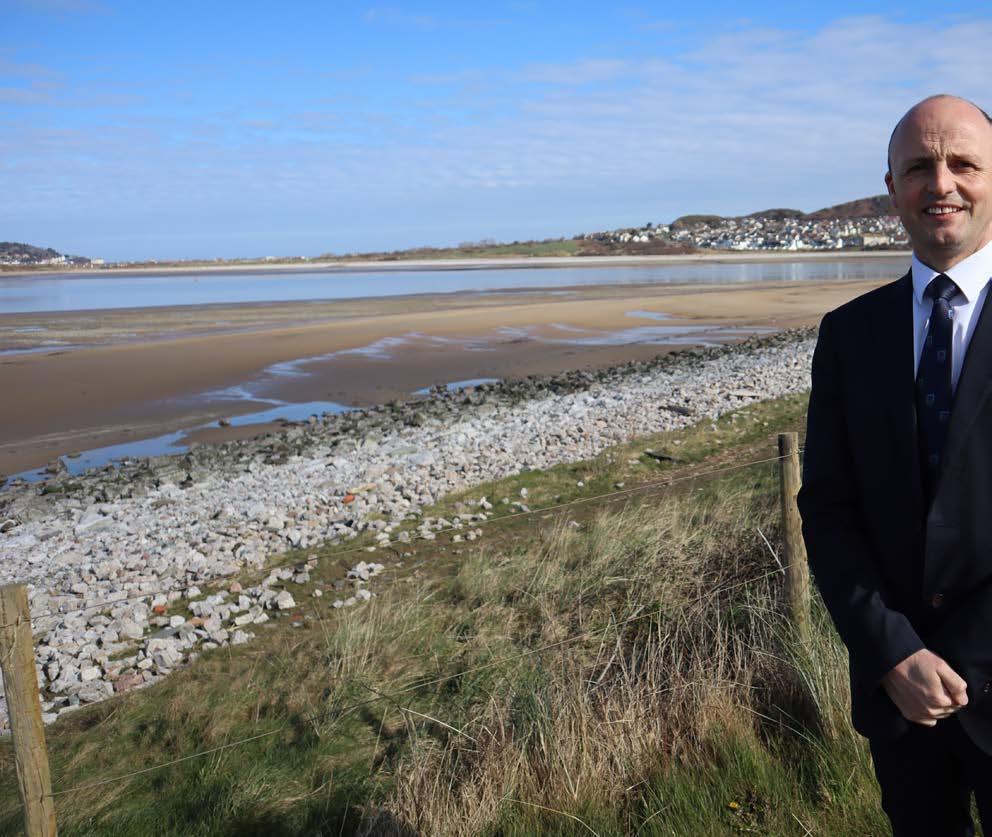
What’s Conwy’s role? What’s the relationship like with The R&A? It’s very good. The R&A are so used to running these events that they put their own stamp on it but they are very mindful of keeping the Curtis Cup identity that has been borne through the LGU. From a club point of view, The R&A are very organised and experienced in global golf events. We know what our role is. We are here to host the event. We have to present the golf course in a condition suitable for an event of that stature and ensure the staff and clubhouse and facilities are equally up to the same standard. How big a deal will it be? It will be the biggest event the club has ever held. For the area, it’s huge. I feel very passionate about Welsh golf and certainly the North Wales coastline that has got some unbelievable golf to offer, which has never attracted enough overseas golfers that the courses deserve.
We’re using this not only to promote the club and the event but also to promote North Wales golf and everything else it has to offer. The geography of Wales itself is very much on a north-south divide – mainly because of the
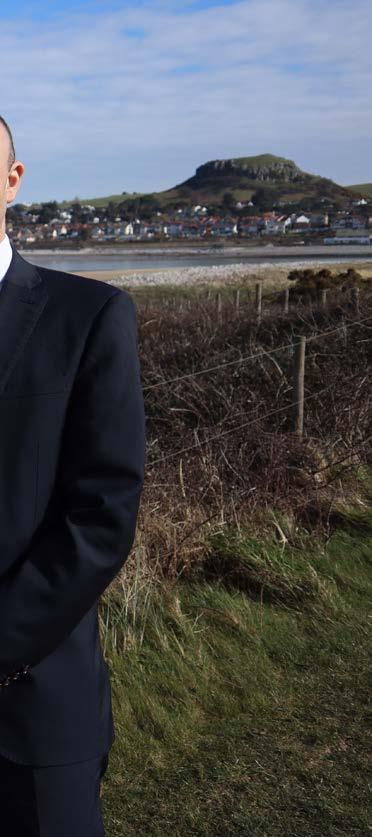
infrastructure and trying to travel between the two.
It’s very difficult and the resort courses down south tend to be where golfers go and play. Logistically, we are very close to Lancashire and Wirral coast and we feel we have a lot to offer.
We’re only an hour’s drive away from Hoylake, for example, and for the golfers who travel there to play, we would hope their natural next step for links golf in Wales would be Conwy. It is interesting that Hoylake members actually founded Conwy GC! If we can get the overseas spectators for the Curtis Cup to spend some time here, they will understand there is some fantastic links golf around the North Wales coast.
There’s so much more to see. North Wales is an exceptional destination for outdoor pursuits. We are less than a mile away from Conwy town, with its amazing castle, which has the town itself inside the castle walls and is full of independent shops, pubs and restaurants. We feel, as an area, we’ve got a lot to offer and it’s going to be very big for us.
It will be a career highlight for you as well. What’s the expectation going to be like? The anticipation is high. It’s never off my mind and it drives me to make sure that everybody here is prepared. It’s exciting. There’s a lot of pressure, so yes it’s going to be a career highlight – being able to be the general manager of a club that hosts the Curtis Cup is something special. But more importantly, it is part of the journey for the club and our mission to become one of the UK’s top links courses, so it is a big part of an even bigger picture for the club that doesn’t stop at the Curtis Cup.
How do you manage pressure? The club will effectively be on show to the world… I come from a sporting family, my father was professional footballer and my brother a professional Rugby League player, so I have been brought up to believe pressure is a privilege, something that has been earned through hard work and is not a problem. I try to work hard, be prepared and to prepare everyone around me with the skills required to do their job and for them to know what is expected of them.
Teamwork is essential. My staff and I love a challenge, a culture I have been keen to promote since arriving at the club. From a club and committee point of view, I am extremely lucky.
This is a club that has held major events before. Not on the scale of the Curtis Cup, but it is nothing new for them. The honours board for international matches and events that have been held here is like a who’s who of amateur and professional golf.
The club is used to it, is very proactive and the Curtis Cup committee is made up of very experienced people. For example, our club captain for the Curtis Cup is JR Jones. JR has officiated at Open Championships and has been around major golfing events for over 20 years, so I am very lucky to have JR and others to discuss things with on a daily basis. It really is a team effort.
Given everything that’s happened, when the tournament does arrive will it be even sweeter? I don’t think it will feel sweeter but if I can look back and think that we’ve kept everyone safe, kept the club running, staff have kept their jobs and we’ve delivered a successful Curtis Cup then, taking into account everything that’s happened, I will be happy! You’re always better for experiences and if we can go through a crisis – a global pandemic – and come out the other side and still deliver that great event then it will make the highlight even bigger. We’ll all be better off for it. The club will continue to improve and it will be something for us to look back on in years to come and certainly learn a lot of lessons. You’ve got to keep positive and keep moving forwards.
Golf Course 2030 (GC2030) was established by The R&A in 2018 to mitigate the impact of climate change, resource constraints and regulation on golf course condition and playability. This will be achieved through a programme of research, education and communications. The research programme has been, in part, informed by the results from a questionnaire survey commissioned by The R&A and undertaken by Sports Marketing Surveys Inc. The survey asked club managers, course managers and PGA professionals their views and experiences of the impact of climate change, resource constraints and regulation in relation to the golf course. Three articles have now appeared in The Golf Club Manager this year, covering the survey responses to each of these challenges, as shown in Figure 1. The final GC2030 article this year will consider how the research programme reflects the views expressed in the survey and how it contributes towards addressing some of the most serious issues affecting the game.
Club managers need to be aware of the challenges of climate change, resource constraints and regulation. Golf Course 2030
Figure 1. Survey responses
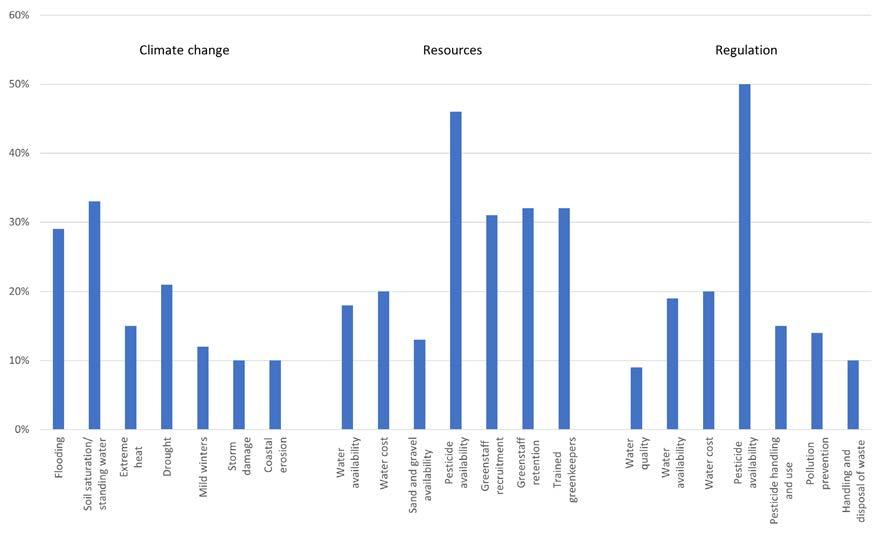
documents for a number of European countries, including Great Britain & Ireland, are available from The R&A website at https:// www.randa.org/en/sustainability/ golfcourse2030, and they highlight a potential worst case scenario should we prove unable to compensate for these threats to the condition of our golf courses:
Longer periods of course closure due to flooding and damage from extreme weather events.
Hotter summers and less water availability for irrigation, resulting in a significant loss of grass cover.
In his final article this year on the Golf Course 2030 project, Steve Isaac, The R&A’s director of sustainability, considers how it’s addressing the most serious issues affecting the game…
Stressed turf due to climate extremes and the loss of coping mechanisms, e.g. irrigation and pesticides, enables diseases, pests and weeds to run riot.
The high cost of resources means less maintenance is possible.
Golf courses providing seriously inferior surfaces compared to what we enjoy today.
The outcome of all of this is loss of customers and permanent closure of many facilities, with serious consequences for the contribution from golf to the local, regional and national economy.
The most serious concerns The most important issues from the responses of club managers to the SMS survey were the availability of pesticides and flooding. The prospect of us seeing more disease scars, insect and worm damage as a consequence of the limited availability of chemicals and weather patterns conducive to such activity is a most worrying one, with its potential to severely impact of the playability of our golf courses. Flooding is, clearly, a threat to golf course condition and playability, and is already being experienced widely.
Three of the 14 Golf Course 2030 projects underway address these

issues directly:
Integrated management of diseases and insect pests on European golf courses: Managed by the Scandinavian Turfgrass and Environment Research Foundation (STERF), this project is investigating sustainable options to the use of pesticides. The focus will be on microdochium patch, dollar spot, chafer grubs and leatherjackets.
Integrated turf management for golf greens, managed by STRI Ltd: This will see the production of a ‘best management’ handbook aimed at those managing parkland golf courses, which will promote positive changes that will be required to address the challenges posed by climate change, resource constraints and regulation.
STRI will also be responsible for delivering the project ‘Water management on golf course 2030: how will it affect the golf industry and what can be done to prepare golf for future climates’. The project will review the impact of climate change on the drainage of golf courses, as well as their water supply and usage.
Other GC2030 projects which may not be obviously related to the issues of pesticide availability or flooding, but that do cover important elements of these challenges are:
Quality standards for the condition and playability of the golf course, managed by STRI and the University Centre Myerscough. These will not provide prescriptive
targets but will outline processes by which realistic standards can be set and measured. Any club wishing to set an objective for what they want from their golf course will have to take the prevailing disease, pest and weed management and weather extremes into account.
The decision-making process for grass selection, managed by STRI: Some grasses are less prone to disease damage than others. With grass breeding seen as an important part of the battle against pests and diseases moving forwards, having this criterion as part of the decision-making process as to which grasses you favour on the golf course could be
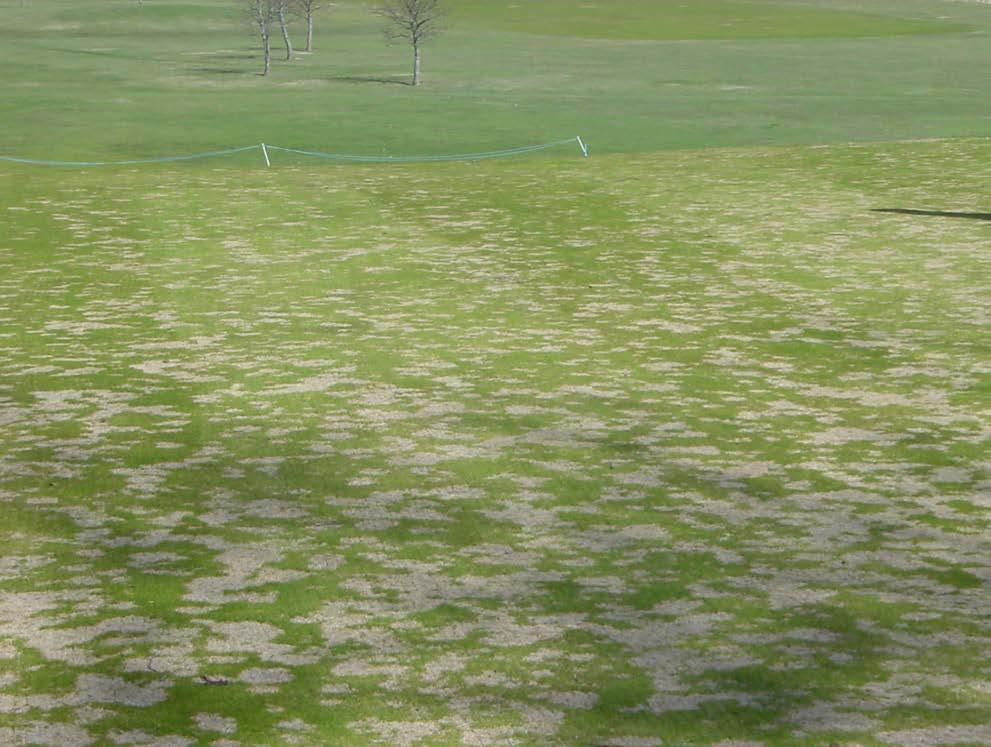
critical.
Adapting to new technologies (as sustainable options for disease, pest and weed management become the norm) and adopting best practice to combat the challenge posed by extreme weather events may well require a fresh look at the content of the education currently provided to our greenkeeping workforce. The GC2030 project ‘Education for the greenkeeping workforce’, managed by SRUC, will address this.
The three projects outlined above will be relevant to all of the issues covered by GC2030 research. The effect of drought was also a notable concern to club managers and the STRI project mentioned previously will consider this. Lack of water was of most concern to club managers based in South East England. Not surprising when the Head of the Environment Agency is predicting that within 25 years England will not have enough water to meet demand and when the primary source of irrigation water for 66% of UK golf courses is mains potable supply.
Coastal management is not a concern to those managing our inland golf courses but the SMS survey showed that it is a real concern to 59% of those managing our coastal, links and clifftop courses. Consequently, GC2030 is running the following

coastal management projects:
A survey of coastal courses to identify current levels of coastal management understanding and engagement across courses likely to be impacted by coastal change. The outcomes of the survey will inform other projects.
A Coastal Management Study, which will produce a structure to enable effective interaction with Shoreline Management Plans and similar broader coastal management processes.
Coastal Management Innovations, which will enable the golfing community to apply innovative coastal management approaches and consider ecosystem benefits in their management decisions, to secure a sustainable long-term future.
A demonstration project for an innovative system of erosion mitigation of coastline at risk, providing proof of concept as a practicable and sustainable technique for mitigation of soft coastline erosion at acceptable cost and environmental impact.
A blue carbon audit to assess how these resources can provide effective opportunities for golf courses in relation to climate and coastal change mitigation and adaptation.
Is Golf Course 2030 addressing the concerns of club managers? The issues club managers
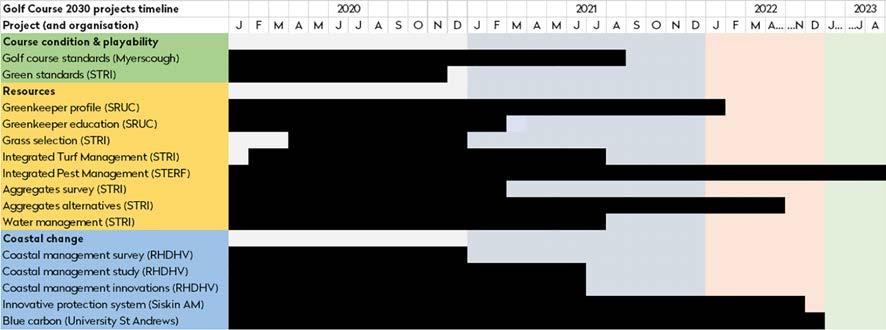
expressed most concern over in the SMS survey are the subject of GC2030 projects. The outcomes of the research will help us drill down to better understand the challenges and to determine what additional work that needs to be done.
So, when will this first tranche of projects complete? Figure 2 presents the timeline for these projects and you can find out more about what they will deliver from The R&A website at https:// www.randa.org/en/sustainability/ gc2030-projects
At the end of the day, GC2030 will be judged on how valuable it is as a source of awareness raising, information from research and education and if these key aspects of the initiative can be applied to help increase the resilience of our golf courses.
As you will be aware, BTME has been cancelled for 2021. However, BIGGA is going to run Virtual Continue to Learn over 19th to 21st January and all of the Golf Course 2030 projects will feature over eight sessions. Tune in if you can.
Figure 2. Golf Course 2030 projects timeline


